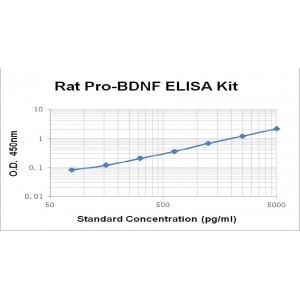More info
Assay Range | 78.1-5,000 pg/mL |
Sensitivity | 4.0 pg/mL |
Specificity | No cross-reaction with other related substances detected |
Size | 96T |
Storage | Store at 2 - 8ºC. Keep reconstituted standard and detection Ab at -20 ºC |
Assay Principle | Sandwich ELISA |
Sample Volume | 100 µL final volume, dilution factor varies on samples |
Detection Method | Chromogenic |
Kit Components
1. Recombinant Rat pro-BDNF standard: 2 vials
2. One 96-well plate coated with Rat pro-BDNF Ab
3. Sample diluent buffer: 12 mL - 1
4. Detection antibody: 540 µL, dilution 1:20
5. Streptavidin-HRP: 600 µL, dilution 1:20
6. Antibody diluent buffer: 12 mL x1
7. Streptavidin-HRP diluent buffer: 12 mL x1
8. TMB developing agent: 10 mL x1
9. Stop solution: 10 mL x1
10. Washing solution (20x): 25 mL x1
Background
BDNF, also known as Abrineurin, is a secreted protein belonging to the nerve growth factor. The full-length BDNF precursor is a 247 amino acid (aa) prepropeptide composed of an 18 aa signal peptide, a 110 aa prosequence, and a 119 aa mature segment. The amino acid sequence of mature BDNF is identical in all mammals examined. Reportedly, the N-terminus of the immature BDNF might be alternatively spliced, generating a longer pre-prosegment (pro-BDNF). The N-terminal pro-BDNF is removed by tPA and produce the 119 aa mature BDNF. BDNF is highly expressed in hippocampus, amygdala, cerebral cortex and cerebellum. It is also expressed in non-neuronal tissues such as heart, lung, skeletal muscle, testis, prostate and placenta. BDNF plays very important roles in a variety of biological processes of central and peripheral systems. During development, it promotes the survival and differentiation of selected neuronal populations. It is involved in axonal growth, pathfinding and in the modulation of dendritic growth and morphology. It regulates synaptic transmission and plasticity at adult synapses in many regions of the brain. BDNF binds to the tyrosine kinase receptor (TrKB) and neurotrophin receptor (NTR) to transduce and mediate the downstream signaling cascades.


